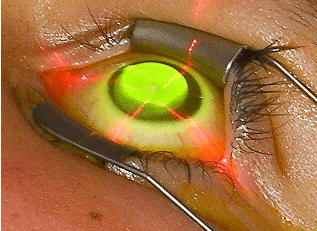What is Implantable Contact Lens(ICL)?
An Implantable Contact Lens (ICL) is a type of corrective vision surgery that involves implanting a contact lens-like device inside the eye to correct refractive errors such as nearsightedness, farsightedness, and astigmatism. Unlike traditional contact lenses that are placed on the surface of the eye, ICLs are surgically inserted into the anterior chamber of the eye, typically behind the iris and in front of the natural lens. They work by altering the way light is focused on the retina, providing clear vision without the need for glasses or traditional contact lenses. ICL surgery is considered a safe and effective option for individuals who are not suitable candidates for laser vision correction procedures like LASIK or PRK.

What it is and How it works?
The ICL is a biocompatible extra lens, similar to a contact lens. The difference is that the ICL is placed inside the eye, rather than on the surface of the eye. The lens is soft and tiny, much like the natural lens, but does not replace it.. The lens works in a similar way as glasses or contact lenses by changing the way light is focused on the retina.
Who can undergo ICL?
The ICL is specially designed to correct Shortsight, Farsight. and Astigmatism The Toric ICL also corrects astigmatism often found in combination with short and farsight. It is approved for use in adults from 21-45yrs of age.
ICL is the treatment of choice for those patients found unsuitable for laser eye surgery due to an out-of-range prescription or abnormal/thinner corneas.

Very high corrections up to -20 D shortsight and +10 D farsight along with 6 D of Astigmatism can be corrected. It can also be used to help patients suffering from Keratoconus who have had cross-linking treatment or the disease has stabilised.
How long will the ICL implant last ?
The ICL implant is designed to remain inside the eye indefinitely. It can be thought of as a permanent contact lens that is maintenance free. However, the lens can be removed at any time in the future should it be necessary.
What is the eligibility to undergo the procedure?
To determine suitability for the procedure a thorough consultation is required where necessary investigations are performed by a highly trained team and followed by an evaluation by a Specialist surgeon.
What to expect during the ICL implantation process?
After attending the consultation the individually tailored lenses are ordered from the manufacturer that the patient is best suited. Depending on the type of lens and the complexity of the prescription, the lenses can take between 1-2 weeks to be ready. Once the lenses have arrived the procedure will only take approximately 30 minutes per eye. It is day care procedure and the recovery time is short.
Advantages of ICL
Since the lens does not permanently alter any structures within the eye or on the cornea, it can easily be removed if necessary. Visual outcomes for higher levels of correction are better with ICL.
The ICL is invisible and undetectable. ICL treatment is completely unaffected if you have thin corneas, dry eyes, or large pupils, as it does not involve removing tissue from the cornea.






